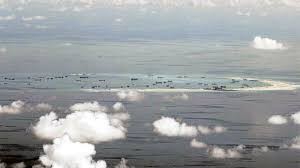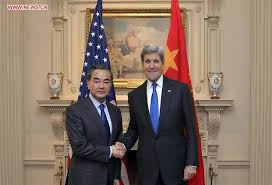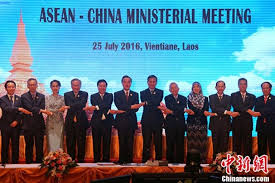 On July 12, the Permanent Court of Arbitration (PCA) gave an award in an arbitration instituted by the Philippines against China over latter’s claims on South China Sea. The arbitration panel, rejecting China’s objections, held that it has powers to make a final and binding award under the relevant provisions of the UN Convention on the Law of the Sea (UN CLOS) to settle the dispute concerning claims of historic rights and sources of maritime entitlements in the South China Sea.
On July 12, the Permanent Court of Arbitration (PCA) gave an award in an arbitration instituted by the Philippines against China over latter’s claims on South China Sea. The arbitration panel, rejecting China’s objections, held that it has powers to make a final and binding award under the relevant provisions of the UN Convention on the Law of the Sea (UN CLOS) to settle the dispute concerning claims of historic rights and sources of maritime entitlements in the South China Sea.
The award is a significant contribution to the understanding of the legal basis of the use of different types of maritime zones by the UNCLOS signatory countries, including different types of offshore land features and consequent maritime entitlements to the resources of the surrounding waters. In this particular case, a peculiarity requiring legal clarification is the Chinese sovereign rights claim – based on its assertion of “historic rights” – to the South China Sea waters encompassed by the so-called “nine-dash lines” which are found in the Chinese maps of the region.
The tribunal looked at the issue of claims made to territorial waters (12 nautical miles from the coastal baselines), exclusive economic zones or EEZ (200 nautical miles from the coastal baselines) and continental shelf (not exceeding 350 nautical miles from the coastal baseline) based on the claimed characteristics of the various South China Sea land features; this issue became important because of extensive land reclamation work done by various claimant countries but, most notably, by China on several land features.
The tribunal did not take any position on the territorial claims made by the various claimant countries, i.e., Indonesia, Malaysia, Brunei, Vietnam, the Philippines and China (and Taiwan); these competing claims have led to occupation of different land features by them which they do not recognize in respect of the others in this group. Nor did the tribunal take any position, on grounds of lack of jurisdiction, on the Philippines complaint about China over the military stand-off over a land feature called Second Thomas Shoal as these activities were of a military nature. It rejected the legal basis under UNCLOS for the Chinese “nine-dash lines” (NDL) and its claim of historical exercise of exclusive control over the encompassed waters or their resources. It also determined, based on archival record, that extensive land reclamations with artificial efforts to sustain a small group of people do not alter maritime entitlements; under the Convention, only land features remaining above water at high tide can generate 12 nautical miles territorial sea and islands, able to sustain human habitation, can generate EEZ or Continental Shelf.
Why South China Sea matters
 The South China Sea island groups have caused considerable military tension since the Second World War after the withdrawal of the Japanese forces from the region. Being traditional fishing grounds, the importance of these islands increased once it was understood that there were good prospects of oil and gas on the seabed although the estimates vary and technology for deep sea oil drilling is not fully developed. In 1974, Chinese troops ousted the Vietnamese from the Paracels islands during the final years of the Vietnam war; in 1988, the two sides clashed in the Spratlys with the loss of over 60 Vietnamese sailors. In 1995, China captured Mischief Reef from the Philippines. Clashes between fishermen from different claimant countries are not uncommon. In the Chinese case, however, its assertion of its claim line has led to serious naval stand-off with both Vietnam as well as the Philippines especially in the context of oil exploration activity.
The South China Sea island groups have caused considerable military tension since the Second World War after the withdrawal of the Japanese forces from the region. Being traditional fishing grounds, the importance of these islands increased once it was understood that there were good prospects of oil and gas on the seabed although the estimates vary and technology for deep sea oil drilling is not fully developed. In 1974, Chinese troops ousted the Vietnamese from the Paracels islands during the final years of the Vietnam war; in 1988, the two sides clashed in the Spratlys with the loss of over 60 Vietnamese sailors. In 1995, China captured Mischief Reef from the Philippines. Clashes between fishermen from different claimant countries are not uncommon. In the Chinese case, however, its assertion of its claim line has led to serious naval stand-off with both Vietnam as well as the Philippines especially in the context of oil exploration activity.
In recent years, the tension has increased sharply in the South China Sea region. It has led to naval buildup amongst the littoral countries.
The rise of Chinese naval power, which was until a decade ago focused more on the East China Sea, has increased anxiety amongst the South China Sea littoral countries and most ASEAN member states have been happy with the return of the US in the region under its policy of ‘rebalance’ towards Asia; its naval, and military, presence has increased and it is developing military-to-military cooperation with several countries in the region, particularly Vietnam, the Philippines, Australia and Indonesia. Whilst the relations of China with the Philippines have worsened considerably, especially during the previous administration of President Aquino, the relations have also become tense with Vietnam and, even, with Indonesia and Malaysia, the latter two being generally quite friendly to it; in the case of Malaysia, China has not been asserting its NDL claims over areas from where the former has been extracting oil.
The South China Sea has been witnessing a vicious downward action-reaction spiral adding to considerable regional tension. China’s aggressive buildup of infrastructure, including airstrips for long-range aircraft, harbour facilities for receiving ships, air defence missile batteries, on several islands have raised temperatures. The US Pacific Fleet’s ‘Freedom of Navigation Operations’ (FONOPs) as well as overflights to contested areas where “international law permits” have elicited angry responses from China; Australia is carrying out its own overflights operations. However, there are as yet no reports of joint freedom of navigation operations along with those of the US Navy. There are almost daily instances of Chinese coast guard ships being involved in interfering with fishing activities by other countries within the NDL areas; other countries are doing the same to the Chinese fishermen.
There have been, not too distant in the past, instances of close confrontation between the naval ships of the US and China as well as between China and those of other countries. In the run-up to the declaration of the arbitration award, the US deployed warships in the Spratlys area closer to the Philippines and the Chinese navy conducted two naval exercises in the Paracels islands; there were communications between the US Secretary of State and the Chinese Foreign Minister urging each other not to raise further tension. At the Singapore dialogue, in June this year, US Defence Secretary issued an unprecedented warning to China against building an airstrip at Scarborough Shoal, a high tide land feature about 230 km from the Philippines coast, about which the tribunal declared as illegal the prevention of Filipino fishermen from fishing by China. The overall level of tension in the region does cause concerns about the safety of navigation and overflights, but the involvement of two big powers, namely, US and China and the active concerns of the other powers can potentially create regional instability with its cascading effects all around; it can be surmised that the timing of active missile tests by North Korea and, indeed, of the South Korean decision to install the US anti-ballistic missile system (THAD) might be linked with the atmosphere of growing regional insecurity.
Impact on China
 Despite the vehement Chinese rejection of the arbitration award, its national leadership cannot be unmindful of the negative impact on its international image especially as it is projecting itself as a responsible international power; in fact, some Chinese analysts have cautioned the government that its current policy might undermine its maritime silk route (MSR) programme for greater influence in the region vis-a-vis US. At an ongoing summit in Ulan Bator, the Chinese Prime Minister met both his Japanese and Vietnamese counterparts and there have been similar conciliatory statements from Beijing and Manila about peaceful resolution of their disputes.
Despite the vehement Chinese rejection of the arbitration award, its national leadership cannot be unmindful of the negative impact on its international image especially as it is projecting itself as a responsible international power; in fact, some Chinese analysts have cautioned the government that its current policy might undermine its maritime silk route (MSR) programme for greater influence in the region vis-a-vis US. At an ongoing summit in Ulan Bator, the Chinese Prime Minister met both his Japanese and Vietnamese counterparts and there have been similar conciliatory statements from Beijing and Manila about peaceful resolution of their disputes.
Whilst US, Japan and Australia have been more forthright in describing the award as final and legally binding on the parties to the dispute under UNCLOS, the ASEAN countries on the South China Sea littoral, namely, Vietnam, Malaysia, Indonesia and the Philippines have been more restrained in their response.
India’s position
India’s official response has been closer to that of the ASEAN claimant countries on the dispute in the Spratlys. It “noted” the arbitration award emphasising freedom of navigation and overflight, and unimpeded commerce, based on “the principles of international law, as reflected notably in the UNCLOS”: it urged “all parties to show utmost respect for the UNCLOS”. Curiously, Chinese diplomats have been citing the Moscow joint communiqué between the foreign ministers of Russia, India and China (18 April 2016) as supporting its position where it says, inter-alia, “all related disputes should be addressed through negotiations and agreements between the parties concerned”; they are ignoring the entire passage of the communiqué which calls upon “full respect of all provisions of UNCLOS”.
India’s concerns about safety of navigation routes and the stability and security of the entire neighbouring region are the basis for its Act East policy where maritime security cooperation with the ASEAN member states is an important dimension. It also has a growing relationship with the US, Japan and Australia in the maritime domain; it has also, recently, launched a maritime dialogue with China to discuss all issues of interest to both sites.
In the immediate aftermath of the arbitration award, all sides are trying to calm the situation which, however, remains combustible with, potentially, disastrous consequences. The attention is to analyse each and every word of the principal protagonists to parse the intentions behind them. Apart from the involvement of the Coast Guards in support of the respective fishing boats which is a daily occurrence, several key countries have been exploring – and, eventually exploiting – hydrocarbon reserves within the NDL area.
Militarisation of the existing infrastructure in the Spratlys and the Paracels, especially on the part of the Chinese, can completely alter the existing balance of power in the region. Although individual ASEAN member countries have differing positions on the dispute, all are keen for an early conclusion with China of the Code of Conduct on the South China Sea. The history of negotiations between the two sides on CBMs in the region does show that a united position produces results. The wide open question is as to whether the changed geopolitics – and extreme fluidity – this time would make things easier.
(Yogendra Kumar is a former Ambassador of India to the Philippines, whose book on India’s maritime challenges has just been published. The views expressed in this column are solely those of the author)
Author Profile
- India Writes Network (www.indiawrites.org) is an emerging think tank and a media-publishing company focused on international affairs & the India Story. Centre for Global India Insights is the research arm of India Writes Network. To subscribe to India and the World, write to editor@indiawrites.org. A venture of TGII Media Private Limited, a leading media, publishing and consultancy company, IWN has carved a niche for balanced and exhaustive reporting and analysis of international affairs. Eminent personalities, politicians, diplomats, authors, strategy gurus and news-makers have contributed to India Writes Network, as also “India and the World,” a magazine focused on global affairs.
Latest entries
 DiplomacyOctober 4, 2025UNGA Resolution 2758 Must Not Be Distorted, One-China Principle Brooks No Challenge
DiplomacyOctober 4, 2025UNGA Resolution 2758 Must Not Be Distorted, One-China Principle Brooks No Challenge India and the WorldJuly 26, 2025MPs, diplomats laud Operation Sindoor, call for national unity to combat Pakistan-sponsored terror
India and the WorldJuly 26, 2025MPs, diplomats laud Operation Sindoor, call for national unity to combat Pakistan-sponsored terror India and the WorldJuly 25, 2025When Fire Ends, Diplomacy Begins
India and the WorldJuly 25, 2025When Fire Ends, Diplomacy Begins India and the WorldJuly 16, 2025Operation Sindoor and its Aftermath: India’s Successful Diplomatic Outreach
India and the WorldJuly 16, 2025Operation Sindoor and its Aftermath: India’s Successful Diplomatic Outreach







